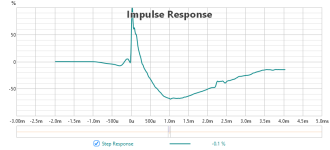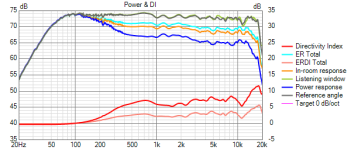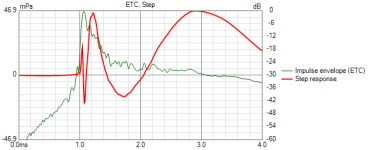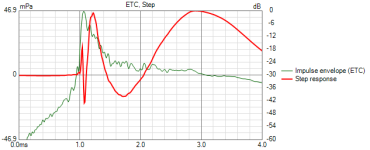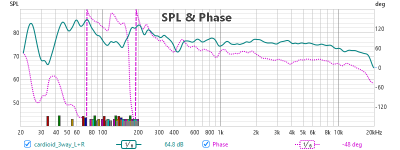First thing that came to my mind was phase alignment mid/tweet. I personally try to get phase to align well, and over as broad range as possible at XO. I find it helps with 'depth' perception in the sound. The mid phase is a bit hard to follow in the graphs, adjusting the delay in the generator could make it easier.
A cap and resistor over the mid coil could be tuned to suck out the resonance at 5k too.
Keep up the good work, I learn a lot from following this thread!
A cap and resistor over the mid coil could be tuned to suck out the resonance at 5k too.
Keep up the good work, I learn a lot from following this thread!
Today is linear phase crossover testing day 🙂
Crossover under test





Here are measurements from 1m away
Ungated

4ms gated


So far it sounds amazing 😀
Crossover under test
Here are measurements from 1m away
Ungated
4ms gated
So far it sounds amazing 😀
Attachments
Last edited:
Today, I tried to hear different tracks and understand if I can pick out differences between linear phase & min phase crossover
Min phase crossover


Linear phase crossover


Impulse response comparison between the two crossovers
Min phase crossover

Linear phase crossover

Now the measurements of the two crossovers from about 1m away (20 degrees off axis).
This is also the same distance at which I sat in front of the speaker for listening.

same measuremrent as above but 3.9ms gated

Impulse response: Min phase crossover

Impulse response: Linear phase crossover

This was all easy to do..
Now comes the hard part where I tried to listen and find differences 😀 where I tried switching between min phase and linear phase crossover multiple times while a song was playing (Please note that this was a test where the responses themselves had a little level difference above 500Hz. So this is not an apples to apples comparison either).
I could find out the effect of level differences in songs with female vocals. Try as I may, I couldn't find out anything which I could attribute specifically to the impulse response differences 😀
Then I think I heard something with tracks having just kickdrums. With the linear phase crossover, the sound of the kickdrum was a little tighter (don't know if this is the right word to use). But with minimum phase crossover, I could hear a little bit of extra boom at the end of every drum beat. I repeated that in a loop. This particular difference, I could make out again and again.. It was sort of once I heard that extra boom, I couldn't unhear it. But in tracks with many other instruments and vocals, I couldn't make this out as clearly as earlier..
Now I don't know, if this is how it is supposed to be in terms of the difference between the impulse responses. But in regular listening, it is very very hard to pick out one over the other for me.. 😀
But I still keep the linear phase crossover just because I heard that extra boom, thinking that it is "better" 😀
Min phase crossover
Linear phase crossover
Impulse response comparison between the two crossovers
Min phase crossover
Linear phase crossover
Now the measurements of the two crossovers from about 1m away (20 degrees off axis).
This is also the same distance at which I sat in front of the speaker for listening.
same measuremrent as above but 3.9ms gated
Impulse response: Min phase crossover
Impulse response: Linear phase crossover
This was all easy to do..
Now comes the hard part where I tried to listen and find differences 😀 where I tried switching between min phase and linear phase crossover multiple times while a song was playing (Please note that this was a test where the responses themselves had a little level difference above 500Hz. So this is not an apples to apples comparison either).
I could find out the effect of level differences in songs with female vocals. Try as I may, I couldn't find out anything which I could attribute specifically to the impulse response differences 😀
Then I think I heard something with tracks having just kickdrums. With the linear phase crossover, the sound of the kickdrum was a little tighter (don't know if this is the right word to use). But with minimum phase crossover, I could hear a little bit of extra boom at the end of every drum beat. I repeated that in a loop. This particular difference, I could make out again and again.. It was sort of once I heard that extra boom, I couldn't unhear it. But in tracks with many other instruments and vocals, I couldn't make this out as clearly as earlier..
Now I don't know, if this is how it is supposed to be in terms of the difference between the impulse responses. But in regular listening, it is very very hard to pick out one over the other for me.. 😀
But I still keep the linear phase crossover just because I heard that extra boom, thinking that it is "better" 😀
Attachments
Your room will add enough on top to hide many of the differences. I expect that the FR differences will be larger (easier to hear) in your case.
Personally, I like linear phase. I went out of my way to get it to behave like that at the listening seat. I compared apples to apples, the phase being the only difference and having the exact same FR response in both cases while doing listening tests. Audibly (and subjectively) it's more attention grabbing than not correcting for this i.m.h.o. It's my personal preference, up to anyone to make up their own mind. I went with a minimum phase behavior of the entire speaker bandwidth, meaning the crossovers were linear phase, but the roll off on each side of the frequency spectrum was untouched.
Personally, I like linear phase. I went out of my way to get it to behave like that at the listening seat. I compared apples to apples, the phase being the only difference and having the exact same FR response in both cases while doing listening tests. Audibly (and subjectively) it's more attention grabbing than not correcting for this i.m.h.o. It's my personal preference, up to anyone to make up their own mind. I went with a minimum phase behavior of the entire speaker bandwidth, meaning the crossovers were linear phase, but the roll off on each side of the frequency spectrum was untouched.
Then I think I heard something with tracks having just kickdrums. With the linear phase crossover, the sound of the kickdrum was a little tighter (don't know if this is the right word to use). But with minimum phase crossover, I could hear a little bit of extra boom at the end of every drum beat. I repeated that in a loop. This particular difference, I could make out again and again.. It was sort of once I heard that extra boom, I couldn't unhear it. But in tracks with many other instruments and vocals, I couldn't make this out as clearly as earlier..
Now I don't know, if this is how it is supposed to be in terms of the difference between the impulse responses. But in regular listening, it is very very hard to pick out one over the other for me.. 😀
But I still keep the linear phase crossover just because I heard that extra boom, thinking that it is "better" 😀
I had a similar impression listening to linear phase Linkwitz-Riley.
CORIGLIANO, J.: Conjurer / Vocalise, track #6 Skin. They beat big drums throughout the track, I guess that's why they called it Skin. To my ear, the flop of the big diaphragms on the initial strike was clearer. I wondered if that was what people mean when they talk about "tight bass" because I have no idea what they mean by that phrase. In addition, linear phase also performed better with spoken voice movie dialogue.
However, the clarity is far more noticeable with linear phase LR-48 compared to linear phase LR24. I don't know what to make of that because the charts aren't much different to my eye. I'm disappointed linear phase seems to sound better because I wanted passive crossovers. I keep rooting for regular LR24s to perform as well as the linear phase LR48s but they don't.
LR48LP
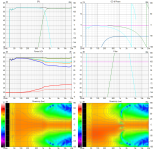
LR24LP
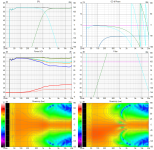
LR24 Regular

Also the basotect i know of has some more resistance to airflow compared to fibrous damping material. I think distortion measurements of the unfiltered midrange can give a clue if that happens with vineeth's smart solution as well.There are studies that indicate the speed of sound in absorbing material can drop to about 100m/sec , so about 1/3. I do not find a study specific with melamine foam, nor one that sort of correlates with the slot approach. Perhaps studies for anechoic room application of melamine foam?
There was a german thread using basotect in the hole in tbe magnet centerpiece of a accution C90-6-079 to damp the helmholtz resonance. https://www.diy-hifi-forum.eu/forum...pezialist!&s=0736d0f0b48cc1d31e4a791cee7372c6
Whisth succesvoll he had to allow the airflow to breathe.
@JanRSmit: Here are plots of the unfiltered mid driver (taken for crossover work)- On axis response

Noise floor on the distortion measurement was high though & my audio interface connected to the mic had its own distortion issues. I also don't know if my mic is able to capture distortion correctly

Burst decay with a 55 dB dynamic range on y-axis

Noise floor on the distortion measurement was high though & my audio interface connected to the mic had its own distortion issues. I also don't know if my mic is able to capture distortion correctly
Burst decay with a 55 dB dynamic range on y-axis
Have you had a chance to try acoustic LR2?
Try it, yo’ll might like it.
Try it, yo’ll might like it.
There is a super secret method to achieve that; take any speaker box, place it close to wall and rotate so that woofer is facing the wall 😀
It's not conventional (a secret!) because speakers tend to be just one box containing all the drivers, and sound is not good if tweeter is also shooting the wall. With little bit of math with wavelength shows that it doesn't matter which way a woofer is up to some frequency depending on the construct, but reflection from the wall could matter. If one cannot position speakers quite far from the wall it's better to couple with it.
The industry is so conventional, and people seem to be very conventional, so small tricks like this are easily dismissed 🙂 All it takes is little bit of brain power and guts to position driver in a place where one cannot see it, and well, at least three way speaker system.
It's not conventional (a secret!) because speakers tend to be just one box containing all the drivers, and sound is not good if tweeter is also shooting the wall. With little bit of math with wavelength shows that it doesn't matter which way a woofer is up to some frequency depending on the construct, but reflection from the wall could matter. If one cannot position speakers quite far from the wall it's better to couple with it.
The industry is so conventional, and people seem to be very conventional, so small tricks like this are easily dismissed 🙂 All it takes is little bit of brain power and guts to position driver in a place where one cannot see it, and well, at least three way speaker system.
Last edited:
@vineethkumar01 check for Roy Allison's works, then wonder what happen in low end about direct radiating drivers directivity when you move them from freefield to a (hard) boundary,... 😉
It's really not different from inwall ( up to a given freq in mid of course).
Martijn is clever in the fact he used this in combination with cardioid for mid+ waveguide for high AND xover freq choosen for transition to the mid.
It allow to locate loudspeakers in the less intruding position in a domestic room ( close to wall) without introducing this much artefact from this same wall ( in fact gaining headroom in low end) and in 90% of time below Schroeder freq of room and at freq where our localisation capability are poor. Very Aikido/Judo'ish in the philosophy used...
Very, very smart approach. Not this different from what Cask05 implemented with his MEH or what Mark100 achieve too. It's just downscaled in size in my view ( and overall potency about SPL and dynamic. Compromise, compromise...).
It's really not different from inwall ( up to a given freq in mid of course).
Martijn is clever in the fact he used this in combination with cardioid for mid+ waveguide for high AND xover freq choosen for transition to the mid.
It allow to locate loudspeakers in the less intruding position in a domestic room ( close to wall) without introducing this much artefact from this same wall ( in fact gaining headroom in low end) and in 90% of time below Schroeder freq of room and at freq where our localisation capability are poor. Very Aikido/Judo'ish in the philosophy used...
Very, very smart approach. Not this different from what Cask05 implemented with his MEH or what Mark100 achieve too. It's just downscaled in size in my view ( and overall potency about SPL and dynamic. Compromise, compromise...).
Last edited:
@tmuikku , assuming a 1st order acoustical co, would this wall firing woofer option work at a co of 400 Hz.?There is a super secret method to achieve that; take any speaker box, place it close to wall and rotate so that woofer is facing the wall 😀
It's not conventional (a secret!) because speakers tend to be just one box containing all the drivers, and sound is not good if tweeter is also shooting the wall. With little bit of math with wavelength shows that it doesn't matter which way a woofer is up to some frequency depending on the construct, but reflection from the wall could matter. If one cannot position speakers quite far from the wall it's better to couple with it.
The industry is so conventional, and people seem to be very conventional, so small tricks like this are easily dismissed 🙂 All it takes is little bit of brain power and guts to position driver in a place where one cannot see it, and well, at least three way speaker system.
Hi,
like always it's not solution for all problems, for example getting xo to 400Hz would require relatively small box because cavity between wall and the speaker close to it also works as acoustic low pass filter, so whether it works for your case depends on size and shape and angle and all kinds of things. In addition the cavity would sustain resonance, edge diffraction applies, and so on.
You could try simulate all of it with ABEC. Here is my 60x40x30cm bass box 10cm from wall, and there is peak right about at crossover (which is about at 200Hz in my system) but this is no problem for me as I've got DSP and the peak is rather uniform to all directions. And, it's much better than the same box, woofer towards listener butt against the wall. Gotta remember though that this is only one wall of six in a cubicle room and there is furniture near by, and so on.


Additional issues with it:
hard to measure at home and verify the performance, be it better or worse than something else. Making ideal anechoic response in simulator based on measurement of the boxes only doesn't exactly apply as the wall is now part of the "speaker" so it's bit of uncovered territory.
Additional bonuses:
don't have to recess the woofer or mind about it's looks as it's hidden. Acoustic low pass filter means less "noise", which ought to mean cleaner sound as also distortion is low passed, if it was audible in the first place.
like always it's not solution for all problems, for example getting xo to 400Hz would require relatively small box because cavity between wall and the speaker close to it also works as acoustic low pass filter, so whether it works for your case depends on size and shape and angle and all kinds of things. In addition the cavity would sustain resonance, edge diffraction applies, and so on.
You could try simulate all of it with ABEC. Here is my 60x40x30cm bass box 10cm from wall, and there is peak right about at crossover (which is about at 200Hz in my system) but this is no problem for me as I've got DSP and the peak is rather uniform to all directions. And, it's much better than the same box, woofer towards listener butt against the wall. Gotta remember though that this is only one wall of six in a cubicle room and there is furniture near by, and so on.


Additional issues with it:
hard to measure at home and verify the performance, be it better or worse than something else. Making ideal anechoic response in simulator based on measurement of the boxes only doesn't exactly apply as the wall is now part of the "speaker" so it's bit of uncovered territory.
Additional bonuses:
don't have to recess the woofer or mind about it's looks as it's hidden. Acoustic low pass filter means less "noise", which ought to mean cleaner sound as also distortion is low passed, if it was audible in the first place.
I have two diy 3/4-way active speakers with downfire sealed bass. AINOgradient is crossed LR2 160Hz (ac) and Gradient 1.4 clone around 300Hz LR2. No problems when listening, but getting good measurements indoor at those freq is problematic, with long gating there is always reflections and modes messing everything up. Speakers are at 80-100cm from front wall.
https://www.diyaudio.com/community/threads/seas-mr18-3-way.322839/page-4#post-5644077
https://www.diyaudio.com/community/threads/seas-mr18-3-way.322839/page-4#post-5644077
Work on both the speakers is complete now.. 😀
Here they are (for now) 🙂

4.2ms gated measurements of the L & R speakers (each taken at 20 degrees off axis)

Measurements of L speaker, R speaker & L+R speakers from listening position (on that chair)

Step response at listening position for L+R speakers 🙂

Frequency magnitude & phase response at MLP

ETC at MLP

On the chair, imaging is superb... It feels like sound is coming from behind the monitor in front of me 😀
Time to seriously listen to some music now.. 😀
Here they are (for now) 🙂
4.2ms gated measurements of the L & R speakers (each taken at 20 degrees off axis)
Measurements of L speaker, R speaker & L+R speakers from listening position (on that chair)
Step response at listening position for L+R speakers 🙂
Frequency magnitude & phase response at MLP
ETC at MLP
On the chair, imaging is superb... It feels like sound is coming from behind the monitor in front of me 😀
Time to seriously listen to some music now.. 😀
Attachments
Last edited:
Wish I could hear them... I am sure you are so pleased with this result.
Yet another flawed attempt to capture the sound using my mobile phone from the listening position.
But let this be here.. 🙂
But let this be here.. 🙂
Some more data and impedance curves for both speakers

I have been noticing the transition between 'direct sound' & 'room sound' (as @tmuikku had been calling it earlier) as I move back away from these speakers.
It is pretty easy to spot the change in sound character.
On the other hand, it was more difficult for me to identify such a transition with my bigger speakers.
I wonder if this has something to do with speaker directivity interacting with the room, especially for speakers with directivity control extended lower down in frequency.
From my limited experience so far, I don't think I will return to lower directivity (below 1kHz) speakers. There are clear and hearable differences in the sound near the speakers as well as further away from them especially in the vocal region. I wonder how much of it is due to the effect of the coaxial drivers and how much of it is due to the closeness of MLP to the speakers also. But one thing I am certain is they sound very different from earlier bookshelf speakers I used to have (which probably had very different frequency responses too).
The overall tonality of the speakers is very similar to my in-ear truthear crinnacle zero IEMs except a tiny bit of elevated treble in the speakers. As of now, I am happy with the speakers' sound as is. But as a next step, I will try to level the response a bit more, dial in a little bit of Room EQ and see if it makes the sound any better 😀
I have been noticing the transition between 'direct sound' & 'room sound' (as @tmuikku had been calling it earlier) as I move back away from these speakers.
It is pretty easy to spot the change in sound character.
On the other hand, it was more difficult for me to identify such a transition with my bigger speakers.
I wonder if this has something to do with speaker directivity interacting with the room, especially for speakers with directivity control extended lower down in frequency.
From my limited experience so far, I don't think I will return to lower directivity (below 1kHz) speakers. There are clear and hearable differences in the sound near the speakers as well as further away from them especially in the vocal region. I wonder how much of it is due to the effect of the coaxial drivers and how much of it is due to the closeness of MLP to the speakers also. But one thing I am certain is they sound very different from earlier bookshelf speakers I used to have (which probably had very different frequency responses too).
The overall tonality of the speakers is very similar to my in-ear truthear crinnacle zero IEMs except a tiny bit of elevated treble in the speakers. As of now, I am happy with the speakers' sound as is. But as a next step, I will try to level the response a bit more, dial in a little bit of Room EQ and see if it makes the sound any better 😀
Last edited:
- Home
- Loudspeakers
- Multi-Way
- A 3 way design study
